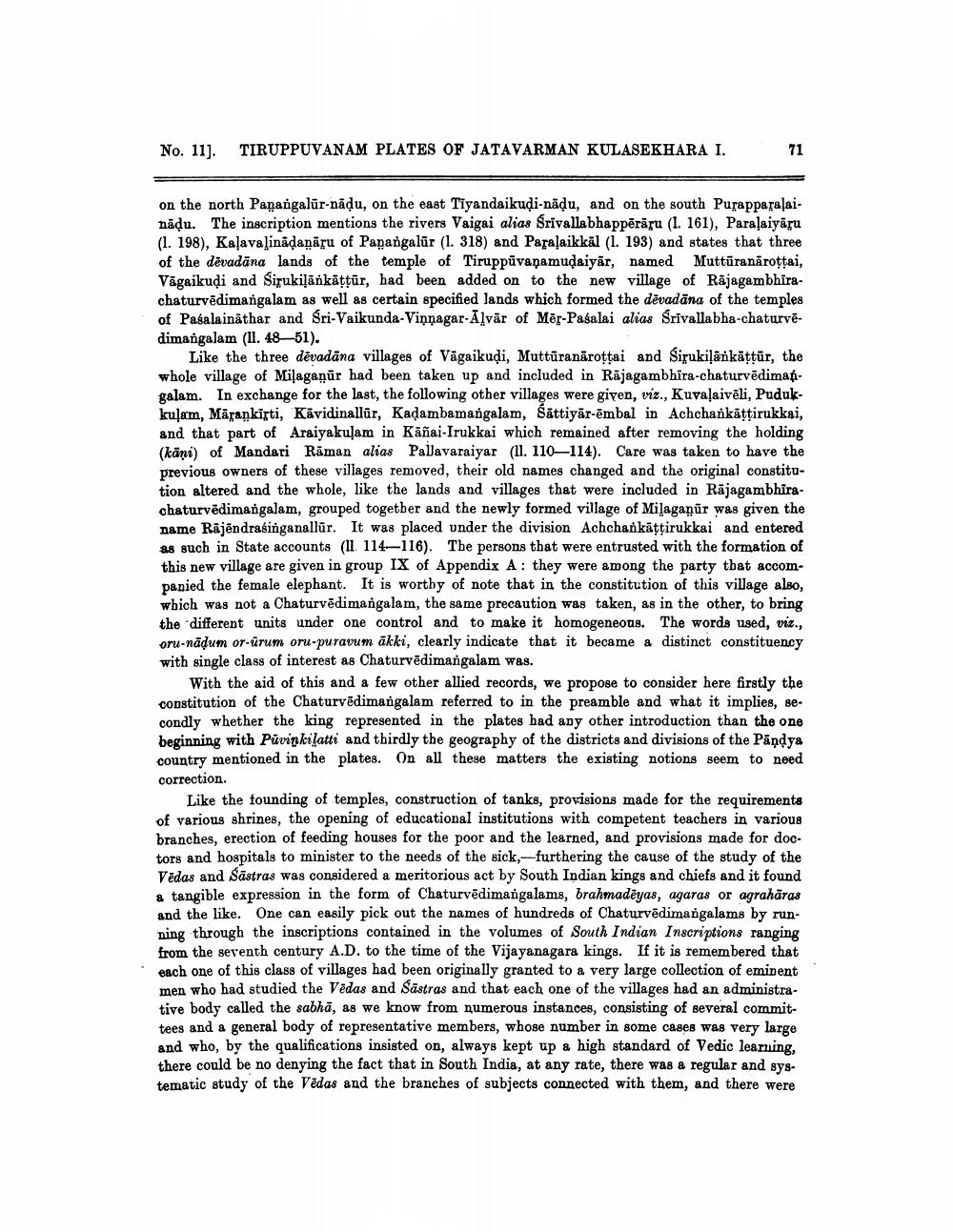________________
No. 11). TIRUPPUVANAM PLATES OF JATAVARMAN KULASEKHARA I.
71
on the north Panangalur-nāļu, on the east Tiyandaikuļi-nādu, and on the south Purapparaļainādu. The inscription mentions the rivers Vaigai alias Srivallabhappērāru (1. 161), Paraļaiyāru (1. 198), Kalavalinadanāru of Panangalur (1. 318) and Paralaikkal (1. 193) and states that three of the devadāna lands of the temple of Tiruppūvanamudaiyar, named Muttūranārottai, Vāgaikudi and Sirukiļānkāţtür, had been added on to the new village of Rājagambhirachaturvēdimangalam as well as certain specified lands which formed the dēvadāna of the temples of Pagalaināthar and Sri-Vaikunda-Vinnagar-Alvar of Mër-Pabalai alias Srivallabha-chaturvē. dimangalam (1l. 48-51).
Like the three dēvadana villages of Vägaikudi, Muttüranärottai and Sirukiļāňkättür, the whole village of Milagaņür had been taken up and included in Räjagambhira-chaturvēdiman. galam. In exchange for the last, the following other villages were given, viz., Kuvaļaivēli, Pudukkulam, Mārankisti, Kāvidinallūr, Kadambamangalam, Sättiyar-ēmbal in Achcharkāțţirukkai, and that part of Araiyakulam in Kāñai-Irukkai which remained after removing the holding (kāni) of Mandari Rāman alias Pallavaraiyar (11. 110–114). Care was taken to have the previous owners of these villages removed, their old names changed and the original constitution altered and the whole, like the lands and villages that were included in Rājagambhirachaturvēdimangalam, grouped together and the newly formed village of Milagañür was given the name Rājēndrasinganallur. It was placed under the division Achchankāțțirukkai and entered as such in State accounts (11. 114-116). The persons that were entrusted with the formation of this new village are given in group IX of Appendix A: they were among the party that accompanied the female elephant. It is worthy of note that in the constitution of this village also, which was not a Chaturvēdimangalam, the same precaution was taken, as in the other, to bring the different units under one control and to make it homogeneous. The words used, viz., oru-nādum or-úrum oru-puravum äkki, clearly indicate that it became a distinct constituency with single class of interest as Chaturvēdimangalam was.
With the aid of this and a few other allied records, we propose to consider here firstly the constitution of the Chaturvēdimangalam referred to in the preamble and what it implies, se condly whether the king represented in the plates had any other introduction than the one beginning with Püvipkilatti and thirdly the geography of the districts and divisions of the Pāņdya country mentioned in the plates. On all these matters the existing notions seem to need correction.
Like the founding of temples, construction of tanks, provisions made for the requirements of various shrines, the opening of educational institutions with competent teachers in various branches, erection of feeding houses for the poor and the learned, and provisions made for doctors and hospitals to minister to the needs of the sick,-furthering the cause of the study of the Vēdas and Sāstras was considered a meritorious act by South Indian kings and chiefs and it found a tangible expression in the form of Chaturvēdimangalams, brahmadēyas, agaras or agrahāras and the like. One can easily pick out the names of hundreds of Chaturvēdimangalams by running through the inscriptions contained in the volumes of South Indian Inscriptions ranging from the seventh century A.D. to the time of the Vijayanagara kings. If it is remembered that each one of this class of villages had been originally granted to a very large collection of eminent men who had studied the Vedas and Sāstras and that each one of the villages had an administrative body called the sabhā, as we know from numerous instances, consisting of several committees and a general body of representative members, whose number in some cases was very large and who, by the qualifications insisted on, always kept up a high standard of Vedic learning, there could be no denying the fact that in South India, at any rate, there was a regular and systematic study of the Vēdas and the branches of subjects connected with them, and there were




